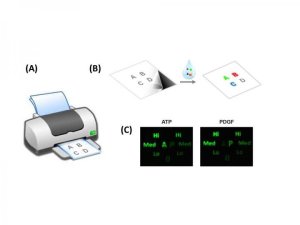
Consumers are one step closer to benefiting from packaging that could give simple text warnings when food is contaminated with deadly pathogens like E. coli and Salmonella, and patients could soon receive real-time diagnoses of infections such as C. difficile right in their doctors’ offices, saving critical time and trips to the lab.
Researchers at McMaster University have developed a new way to print paper biosensors, simplifying the diagnosis of many bacterial and respiratory infections.
The new platform is the latest in a progression of paper-based screening technologies, which now enable users to generate a clear, simple answer in the form of letters and symbols that appear on the test paper to indicate the presence of infection or contamination in people, food or the environment.
“The simplicity of use makes the system easy and cheap to implement in the field or in the doctor’s office,” says John Brennan, director of McMaster’s Biointerfaces Institute, where the work was done with biochemist Yingfu Li and graduate student Carmen Carrasquilla.
“Imagine being able to clearly identify contaminated meat, vegetables or fruit. For patients suspected of having infectious diseases like C. diff, this technology allows doctors to quickly and simply diagnose their illnesses, saving time and expediting what could be life-saving treatments. This method can be extended to virtually any compound, be it a small molecule, bacterial cell or virus,” he says.
The research, in its formative stage, addresses a key problem facing current paper-based biosensing techniques which are labour-intensive, sometimes costly and inconvenient, and often difficult to mass produce.
Using state-of-the-art methods to produce “bio-inks,” researchers can now use conventional office ink-jet printers to print human-made DNA molecules with very high molecular weight on paper, much like printing a letter in an office. The sheer size of the DNA — which produces a signal when a specific disease biomarker is present — is enough to ensure it remains immobilized and therefore stable. The paper sensor emerges from the printer ready to use, like pH paper.
The implications are significant, says Brennan, since the new technology could be used in many fields where quick answers to important questions are critical.
“We could conceivably adapt this for numerous applications which would include rapid detection of cancer or monitoring toxins in the water supply,” says Brennan. “There are hundreds of possibilities.”
Story Source:
The above story is based on materials provided by McMaster University. The original article was written by Michelle Donovan. Note: Materials may be edited for content and length.
Journal Reference:
- Carmen Carrasquilla, Jessamyn R. L. Little, Yingfu Li, John D. Brennan. Patterned Paper Sensors Printed with Long-Chain DNA Aptamers. Chemistry – A European Journal, 2015; DOI: 10.1002/chem.201500949
